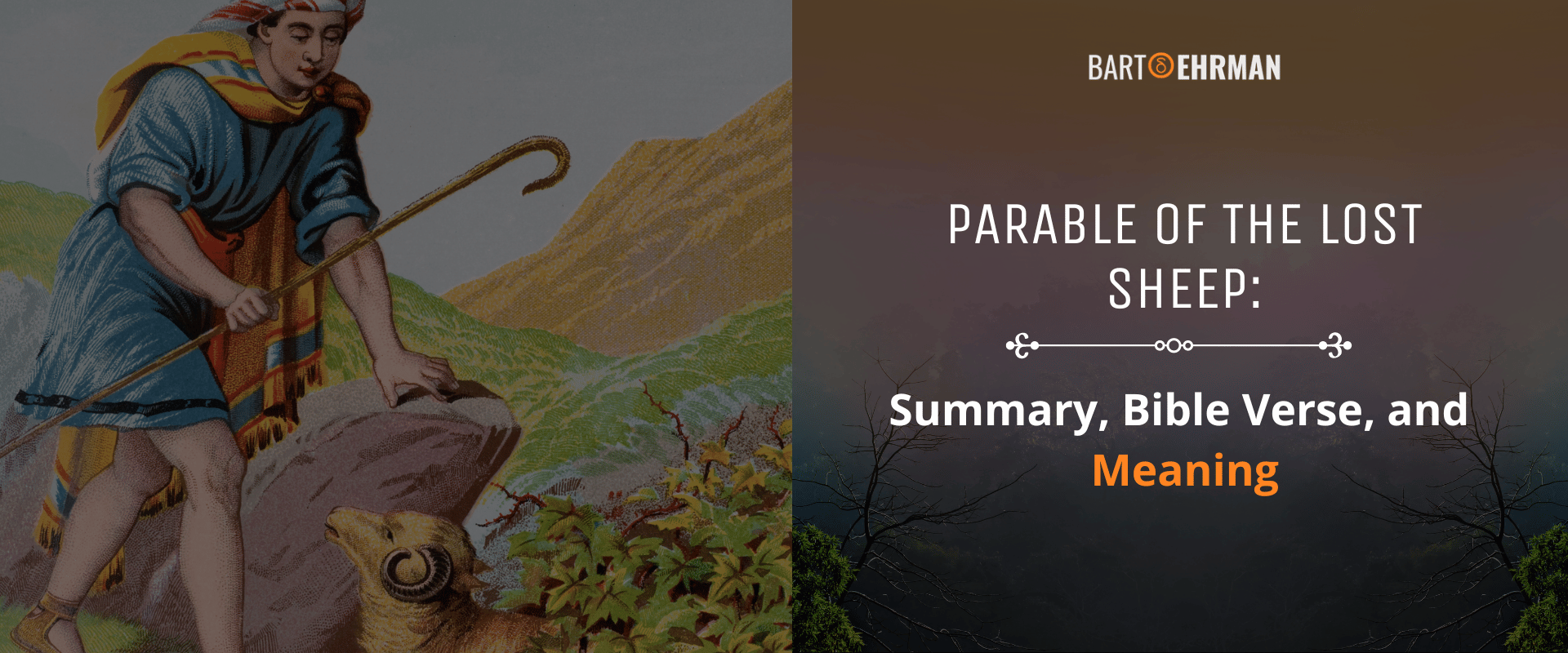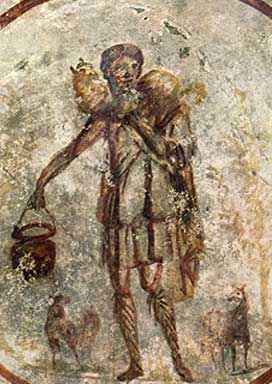Parable of the Lost Sheep: Summary, Bible Verse, & Meaning

Written by Joshua Schachterle, Ph.D
Author | Professor | Scholar
Author | Professor | BE Contributor
Verified! See our editorial guidelines
Verified! See our guidelines
Edited by Laura Robinson, Ph.D.
Date written: October 4th, 2024
Disclaimer: The views and opinions expressed in this article belong to the author and do not necessarily match my own. - Dr. Bart D. Ehrman
The Parable of the Lost Sheep, found in two of the canonical Gospels, offers insights into themes of loss, redemption, and divine compassion. This brief yet poignant allegory resonated deeply with early Christian communities.
In this article, I’ll examine the lost sheep parable's implications and its conceptual roots. I'll also consider its interpretations in two noncanonical texts, exploring its malleability in early Christian thought.

The Parable of the Lost Sheep in Matthew and Luke
In the canonical Gospels, the Parable of the Lost Sheep is only found in Matthew and Luke. Although Matthew and Luke used Mark as their main source, Mark doesn’t contain this parable. Since it is shared by Matthew and Luke but not included in Mark, most scholars assign this parable to a source they call Q (from the German word for source, Quelle).
Let’s take a look at Matthew and Luke’s versions. They are clearly similar but have a few interesting differences, as well. Here’s Matthew 18:12-14:
What do you think? If a shepherd has a hundred sheep and one of them has gone astray, does he not leave the ninety-nine on the mountains and go in search of the one that went astray? And if he finds it, truly I tell you, he rejoices over it more than over the ninety-nine that never went astray. So it is not the will of your Father in heaven that one of these little ones should be lost.
What is the significance of Jesus and the sheep? The most obvious interpretation of the Parable of the Lost Sheep is related to the Jesus-following communities who were Matthew’s audience. In Matthew, while those community members who remain faithful to Jesus are good, members who are seduced away from the community — that is, they “go astray” — and then return are even more valued. This implies that Matthew’s Christian community lost members regularly and that its members were expected to search out these parties and convince them to come back.
(Affiliate Disclaimer: We may earn commissions on products you purchase through this page at no additional cost to you. Thank you for supporting our site!)
In A Rabbi Looks at Jesus’ Parables, Frank Stern notes that this parable features themes commonly found in the Hebrew Bible, where God is often portrayed as a shepherd in his care for Israel, his “flock.” In Isaiah 40:11, for instance, we see the following:
He will feed his flock like a shepherd;
he will gather the lambs in his arms
Likewise, Ezekiel 34:11-12 and 16 speaks of how God will care for his people:
For thus says the Lord God: I myself will search for my sheep and will sort them out. As shepherds sort out their flocks when they are among scattered sheep, so I will sort out my sheep. I will rescue them from all the places to which they have been scattered on a day of clouds and thick darkness… I will seek the lost, and I will bring back the strays…
Notice that in Matthew’s version of the parable, God rejoices over the return of the stray. This is slightly different In the version found in Luke 15:3-7:
So he told them this parable: “Which one of you, having a hundred sheep and losing one of them, does not leave the ninety-nine in the wilderness and go after the one that is lost until he finds it? And when he has found it, he lays it on his shoulders and rejoices. And when he comes home, he calls together his friends and neighbors, saying to them, ‘Rejoice with me, for I have found my lost sheep.’ Just so, I tell you, there will be more joy in heaven over one sinner who repents than over ninety-nine righteous persons who need no repentance.
In The Challenge of Jesus’ Parables, Richard Longnecker notes that the Parable of the Lost Sheep in Luke is followed by the Parables of the Lost Coin and the Prodigal Son, all linked thematically to losing, searching, finding, and rejoicing over something valuable.
In The Parables of Jesus: A Commentary, Arland Hultgren writes that one notable difference between Matthew’s and Luke’s versions of this parable is the verb. In Matthew, the sheep has “gone astray,” making the sheep itself the agent of the loss. In Luke, however, the shepherd is responsible for “losing” the sheep, which could imply that the shepherd’s lack of attentiveness caused the circumstances. If the shepherd represents God, this could be interpreted as a bold statement about God’s part in a community member going astray.
Note also that in Luke’s version, the shepherd does not rejoice alone, but with friends and neighbors, a collective celebration not unlike that in another parable, when the Prodigal Son returns home to his father.
In Luke’s version, those who go astray are not merely leaving the community but sinning. In other words, while Matthew’s community sees the parable as addressing those who have left the community, Luke’s views it as being about any member who sins, even if they stay in the community.
In his commentary on the Gospel of Luke, Joel Green writes that the Parables of the Lost Sheep, the Lost Coin, and the Prodigal Son “are fundamentally about God, ... their aim is to lay bare the nature of the divine response to the recovery of the lost.” He additionally notes that the notion of God’s elation at the reclamation of sinners is implicitly compared with the condemnation of sinners from the religious leaders with whom Jesus argues.
By the way, the Jesus Seminar, a group of biblical scholars who studied the historicity of Jesus’ sayings in the Gospels, voted unanimously that the Parable of the Lost Sheep was indeed one of the historical Jesus’ parables, according to their report The Parables of Jesus: Red Letter Edition. Its general themes fit well with Jesus’ preaching on the character of God and how God relates to the faithful.
In many later interpretations, Jesus himself was considered the shepherd in the story. In Art in the Early Church, Walter Lowrie notes that the image from Luke’s version of the shepherd putting the lost sheep on his shoulders was often used to depict Jesus as the Good Shepherd.

Source: Allegory of Christ as the Good Shepherd, 3rd century. This file has been identified as being free of known restrictions under copyright law, including all related and neighboring rights.
Having looked at the Parable of the Lost Sheep in our canonical Gospels, let’s look at two versions from outside the biblical canon.
FREE COURSE!
WHY I AM NOT A CHRISTIAN
Raw, honest, and enlightening. Bart's story of why he deconverted from the Christian faith.
Over 6,000 enrolled!
Parable of the Lost Sheep: Gospel of Thomas and Gospel of Truth
The Gospel of Thomas was written in the 1st or early 2nd century. It contains no narratives but claims to be the sayings of Jesus written down by someone named Didymus Judas Thomas. This seems to be an attempt by the unknown author to claim that the apostle Thomas wrote the gospel. It was discovered in 1945 near Nag Hammadi, Egypt along with many other early Christian writings.
The Gospel of Thomas contains 114 sayings, some of which are quite similar to sayings from Matthew and Luke, including the Parable of the Lost Sheep. We find this version in saying 107:
Jesus said, “The kingdom is like a shepherd who had a hundred sheep. One of them, the largest, went astray. He left the ninety-nine sheep and looked for that one until he found it. When he had gone to such trouble, he said to the sheep, ‘I care for you more than the ninety-nine.’”
The first and most obvious difference between this version and those in the canon is that Thomas makes this a parable about the Kingdom of God, clearly one of the principal themes in Jesus’ teachings, whereas Matthew and Luke imply that it is about the earthly community.
Another clear difference, though, is that the sheep that is lost in Thomas is “the largest,” implying that it was already the most valued before its disappearance from the flock. It’s difficult to deduce the intended meaning of this detail when the versions in Matthew and Luke suggest that the lost sheep could be anyone. Perhaps Thomas is implying that one who is already favored is more likely to go astray, although it’s hard to know for certain.
Next, let’s look at the fourth and final version from another non-canonical gospel, the Gospel of Truth. Like the Gospel of Thomas, this text was discovered in 1945 near Nag Hammadi, Egypt. It has long been considered a “Gnostic” text, although as I wrote in another article, most scholars consider that broad label problematic. Here’s the Parable of the Lost Sheep in the Gospel of Truth:
[Jesus] is the shepherd who left behind the ninety-nine sheep which had not strayed and went in search of that one which was lost. He rejoiced when he had found it. For ninety-nine is a number of the left hand, which holds it. The moment he finds the one, however, the whole number is transferred to the right hand. Thus it is with him who lacks the one, that is, the entire right hand which attracts that in which it is deficient, seizes it from the left side and transfers it to the right. In this way, then, the number becomes one hundred. This number signifies the Father.
In this version, Jesus himself is said to be the shepherd of the parable, and the actual numbers — the 99 who are not lost, the one who strays, the complete flock of 100 — seem to be emphasized. Without going into too much detail, this is a form of numerology, a practice whereby people found divine or mystical significance in numbers. Many, orthodox Christians and Jews included, employed numerology to interpret texts and events in the ancient world.
It’s difficult to say whether in this version, the stray sheep actually represents a person, as we think of it, or merely a soul. In The Nag Hammadi Scriptures, Einar Thomasson writes that, in the Gospel of Truth, God is said to have sent Jesus to the world to eradicate ignorance and perfect humans, thus allowing them to return to the unity with the Father with which they had begun.
This is clearly the point of the parable in the Gospel of Truth. Once the one who goes astray (an ignorant soul or human being) is restored, unity with the Father can be reestablished. This is quite different from the other three versions, despite its use of the same core ideas.

Conclusion
The Synoptic Gospels contain more than 30 parables (Arland Hultgren and other scholars insist that the Gospel of John has no parables, although there is some disagreement about this). Mark, our earliest Gospel, has eight parables, two of which are found only in Mark. Matthew contains 23 parables, with 11 unique to Matthew, while Luke contains the most — 24 parables — with 18 of them found only in Luke. What, then, is the importance of the short parable known as the Parable of the Lost Sheep?
Although it is brief, the Parable of the Lost Sheep is significant in Matthew and Luke, drawing on the classic Hebrew Bible theme of God as a shepherd caring for his people, the sheep. Both Matthew and Luke emphasize the importance of allowing those who go astray within their communities to return and forgiving them completely rather than judging them.
The lost sheep parable appears also in two non-canonical gospels, the Gospel of Thomas and the Gospel of Truth. In Thomas, it is not about the current community of Christians, but rather the coming Kingdom of God. In the Gospel of Truth, however, Jesus is the shepherd whom God sent to gather those people or souls who had gotten “lost,” falling away from unity with the Father. Finding the one lost soul and gathering all together would reestablish the divine unity with which the universe had begun.
It's remarkable that such a short parable could have such enduring significance in Christian communities, but the theme of Jesus as the Good Shepherd continues to be found in Christian art today, just as it was in the churches of some of the earliest Christian groups many centuries ago.
FREE COURSE!
WHY I AM NOT A CHRISTIAN
Raw, honest, and enlightening. Bart's story of why he deconverted from the Christian faith.
Over 6,000 enrolled!
